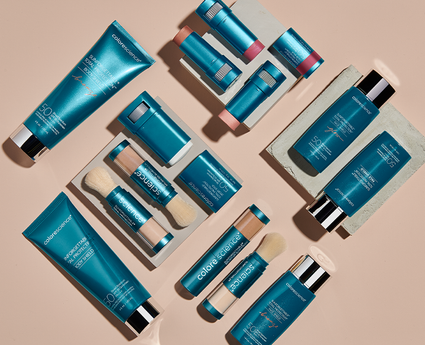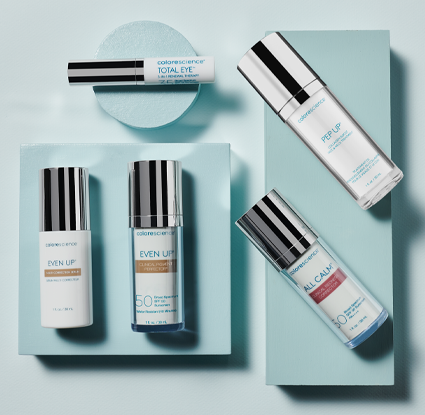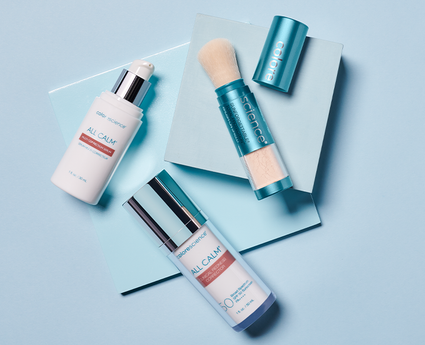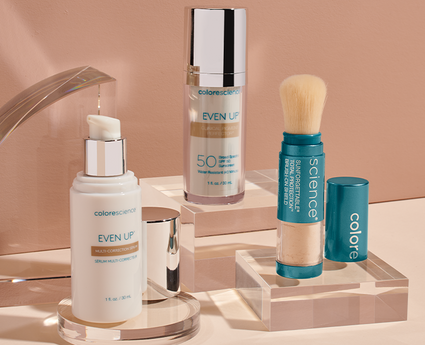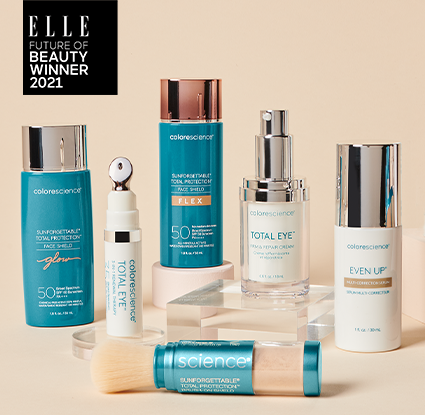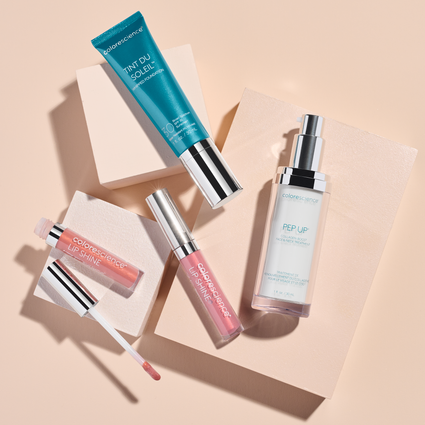What Is My Skin Tone? A Guide to Finding Your Undertone
Have you ever wandered up and down the cosmetic aisle looking for your next product, but got stuck asking yourself, “How do I determine my skin tone?” If so, you’re not alone.
Determining your skin tone can be a daunting task and buying the right shades to beautify your complexion is sometimes overwhelming.
The wrong foundation, concealer, bronzer or blush can create an unflattering palette that doesn’t do your beauty justice. Your makeup needs to blend seamlessly with your natural skin tone at the jawline to avoid looking unnatural or ‘caked’, and determining your skin tone is paramount for accomplishing this task.
To help you achieve a flawless finish, we’ve put together this comprehensive guide on how you can (correctly!) discover your skin tone—and prevent those dreaded makeup disasters. Keep reading to learn how you can finally get the answer to “what is my skin tone?” or use the links below to navigate the post.
- What is Skin Tone?
- What are Skin Undertones?
- What is Skin Complexion?
- What Factors Can Impact Your Skin Tone?
- How to Determine Your Skin Tone
- Why is it Useful to Know My Skin Tone?
- Buying the Right Makeup
- What’s the Best Foundation for Me?
- Colorscience Mineral Cosmetics for all Skin Tones
- What is My Skin Tone? FAQs
- What is My Skin Tone? Key Takeaways
- Find Your Skin Tone & Revamp Your Routine
What is Skin Tone?
The “tone” of your skin is the genetically endowed amount of melanin in your epidermis (the outermost layer of skin). Melanin—a complex polymer produced by cells called melanocytes—refers to a group of naturally-occurring dark brown or black pigments present in human skin (and animals, too!).
When the skin is exposed to damaging ultraviolet light from the sun, melanocytes kick into overdrive as a natural defense mechanism, producing an abundant amount of melanin spread across the epidermis to absorb the sun’s harmful rays.
For that reason, determining your skin tone will vary depending on how much time you spend in unprotected sun exposure, but the skin tone you were born with is based on your genetic makeup. Our ancestors adapted to their environment; those in sunnier regions and climates evolved to naturally produce more melanin for sun protection, and therefore had darker skin tones. It’s hard to group skin tones into categories, since each of us has uniquely varying hues, but generally speaking, there are three different categories you can use to determine your skin tone:
- Light: Light or fair skin tones tend to historically derive from northern European countries which faced frequent snow or cloud coverage, and therefore did not need much melanin protection. Paler people are usually very sensitive to the sun and burn much easier than those with darker skin. If you find that this is your skin tone, be extra diligent with your UV protection and consider daily sunscreen usage to prevent burning and photoaging.
- Medium: Medium complexions are typical of Southern Europe and Northern Asian descent. Sometimes referred to as “olive”, this skin tone is a neutral, well-balanced beige appearance and will make finding the right foundation shade much easier. If you determine this is your skin tone, you probably tan well in the sun (note: that doesn’t mean you’re immune to sun-related aging!).
- Note: Be sure to apply–and reapply–sunscreen daily. Even if you don't burn, everyone is susceptible to skin cancer and sun damage.
- Dark: Dark complexions typically originate from parts of the world that have the most exposure to ultraviolet radiation, such as the Middle East, India, and Africa. As with those who have medium skin, you are not exempt from sun damage if you have this skin tone. In fact, you're more prone to hyperpigmentation and you’re still susceptible to skin cancer, so hold onto that sunscreen!
Again, these three skin tone names are speaking in broad, general terms which can be broken down to much smaller specifications. For example, you can differentiate between light and fair, while “dark” could mean espresso, brown or ebony. Determining skin tone and its slight variations depends on your unique undertone.

What are Skin Undertones?
If you have ever shopped for cosmetics with color coverage, you’ve probably heard the terms “cool”, “warm”, and “neutral” describing different shades of skin tone. These terms refer to the skin’s “undertone,” or the subtle, muted color beneath your skin’s surface. Think of it as a shadow that’s always there; while your determined skin tone may change, the undertone remains the same. Learning how to answer “what is my undertone color?” is important. Being able to find the right cosmetic relies largely on matching your unique undertone. Let’s break down the different undertones:
- Cool: red and pink with bluish hints
- Warm: yellow, peachy and golden hues
- Neutral: olive or a balanced mix of the shades above
See the skin tone chart below for reference.

The surface color of your skin tone, or the first thing you see when you look in the mirror, may appear ruddy, but your undertone could be golden or yellow.
Therefore, when determining your skin tone for foundation, liquid foundation, concealer or any other type of cosmetic, pay equal importance to your undertone.
Looking for makeup that does more?
Colorescience mineral cosmetics combine the aesthetics of color coverage with advanced skincare ingredients and all-mineral sunscreen to protect and perfect skin
SHOP NOWWhat is Skin Complexion?
Before teaching you how to determine your skin tone for those who are still unsure, it’s worth noting that skin tone and complexion are not one and the same; tone refers to the color of your skin while your complexion encompasses your overall appearance. Think of rosy, red cheeks or dark under-eye circles; “complexion” includes these colors in addition to your natural skin tone. It also refers to texture, such as dry versus oily. Learn more about identifying your skin type here.
Pick products suited to your complexion as well as tone, i.e. those looking to reduce shine and redness should seek mattifying products, or those with uneven tone should find color correctors, and so forth.
What Factors Can Impact Your Skin Tone?
There are quite a few factors that can impact your skin tone, but ultimately your skin tone is determined by your melanin, which is a product of your genetic makeup. Melanin is produced by cells that are called melanocytes that are in the skin, and they are the primary determinant of skin color in people. Depending on your ethnicity and where your ancestors are from, you may have a higher amount of melanin in your skin, which helps to protect you and your skin from UV radiation-induced molecular damage. The warmer and sunnier your native region is, the more melanin your skin is likely to contain.
Your genetics determine how light or how dark your skin can range, but your sun exposure can add to it as well. If you are naturally paler and stay inside frequently, you are bound to have a more ivory complexion. If you naturally have darker skin and you spend a lot of time outside when tanning or just enjoying the outdoors, you are sure to get darker with more and more sun exposure. This means the two main factors that impact your skin tone are your genetic makeup and what your skin does with sun exposure.
When you are trying to determine what color your skin tone is, you want to be aware of those two factors. Being aware of your natural skin pigment and genetic dispositions, and knowing the impacts sun exposure can have on your skin can work to your advantage when it comes to finding your skin tone.
How to Determine Your Skin Tone
Before going up and down that cosmetic aisle to find the perfect product, check out this handful of ways to determine skin tone and nail your perfect match:
Look at Your Face in Natural Light
If you notice a gray tone when you’re wearing makeup, your foundation doesn’t compliment your undertones.
Here’s how to check your skin tone in natural light:- Thoroughly wash your face clear of any makeup or grime.
- Wait at least 15 minutes and find some natural lighting, since different lighting affects the appearance of your skin (we all know fluorescent light does no one any favors).
- Grab a small mirror and head out into the sunlight or a well-lit window to determine your most natural tone.
- Observe your jawline (it’s usually less affected by color changes than the rest of your face) to find your surface color; remember, the jaw is where you need to blend, so this is the shade you need to match!
The Silver/Gold Test
If silver complements your skin better than gold, you likely have cool undertones. If you have warm skin tones, gold likely looks better—helpful information when it comes to shopping for jewelry!
Look at Your Veins
In natural light, check the appearance of your veins beneath your skin.
- If your veins appear blue or purple, you have a cool skin tone.
- If your veins look green or a greenish blue, you have a warm skin tone.
- If you can’t tell whether or not your veins are green or blue, you probably have a neutral skin tone. Those of you with an olive complexion will probably fall into this category.
How Does Your Skin React to Sun Exposure?
When you’re out in the sun, does your skin tan easily? Do you rarely sunburn? Examining the way your skin reacts to the sun’s rays can help you determine skin tone. Those who tan easily have a medium or dark skin tone, while those who burn easily likely have a very fair skin tone.
When taking the steps to determine your skin tone, you want to be sure that your skin is completely clean and free of all of your makeup or debris that can interfere with your observations.
If you have any remnant mineral foundation, leftover eye makeup, or you use bronzing primer and you didn’t quite wipe it all off, that can influence how your skin tone appears and interfere with you finding the right products for your complexion. Finding your skin tone requires you to work with a blank canvas.
Once your skin is free and clear of all outside influences, you can get down to finding your skin tone, and start to create a plan for updating makeup, personalized skin care, and even fashion choices to work for you instead of against you

Why Is It Useful to Know My Skin Tone?
Understanding your skin tone and undertones is useful in everyday life, from selecting makeup to outfit choices and creating your overall aesthetic. Knowing your specific skin tone color helps you choose the right foundation, concealer, and other cosmetics to create a seamless and natural look. When it comes to choosing lipstick and blush colors, ones that harmonize with the undertones of your skin will enhance your look.
Along with guiding your makeup choices, knowledge of your skin tone color will help you select clothing that accentuates your natural features and radiance. Wearing colors that clash with your complexion can give you the appearance of dull skin.
Similarly, you should consider your skin tone when changing hair color. Creating harmony between your hair and skin results in a more flattering and cohesive look. Basically, if you want to look and feel your best, knowing your skin tone and the undertones of your skin is essential.
Buying the Right Makeup
Now that you know how to determine your skin tone, it’s time to start finding the right cosmetics to beautify your complexion. If you can determine the skin tone that goes with the corresponding color, perfect makeup application will be a breeze.
-
Cool Undertones
If you determine your skin undertone is cool, consider: blue-based eye shadows, accentuated lips in red, pink or purple hues, and enhancing your pink pigment with pale, rosy blush. -
Warm Undertones
Those with golden brown skin should try: earthy eye shadows to compliment a natural yellow glow, highlight cheeks with a coral blush or illuminating pearl powder, and find lip shades of a darker red. -
Neutral Undertones
If you’ve determined your skin tone is neutral, lucky you. Just about any cosmetic looks great on your complexion. Consider instead wearing colors which compliment your eyes and hair.
Enhance your natural beauty with the Mineral Corrector Palette with SPF 20 which has SPF protection and color corrects red, blue, and yellow tones on the skin.

Note: When shopping for foundation, particularly if you need foundation for sensitive skin, always start with a small test patch (at the jaw) to determine if your skin tone matches the given product. Keep in mind that your tone will vary by season, and that many women choose to go one shade lighter or darker than their surface color based on preference.
What’s the Best Foundation for Me?
To select the ideal foundation for your skin tone, you should have a basic understanding of:
- Skin undertones
- Texture preferences
- Coverage needs
Before purchasing a foundation, consider your skin type, whether it’s oily, dry, or combination. You should also figure out whether your undertone is warm, cool, or neutral to find your perfect match.
Here are some recommendations for foundations based on skin type and your concerns:
- Even Up Clinical Pigment Perfector SPF 50: For those with age spots or discoloration to correct with clinically-proven ingredients and protect with all-mineral SPF 50.
- Tint du Soleil SPF 30 Whipped Foundation: For those with mature or drier skin, this foundation is packed with a nourishing multi-vitamin complex and collagen-building peptides to improve skin's elasticity and ability to retain moisture while protecting with all-mineral SPF 20
- Sunforgettable Total Protection Face Shield Flex SPF 50: Suitable for all skin types, including sensitive and acneic, this lightweight mineral sunscreen with tinted color coverage is packed with advanced antioxidants and niacinamide to brighten and treat skin while protecting with all-mineral SPF 50.
- Natural Finish Mineral Foundation SPF 20: This is better for oily skin types to lightly absorb excess sebum and protect with all-mineral SPF 20.
When choosing a foundation for your skin tone, look at the shade options and select the one that best matches you. It’s worth noting that some foundations are designed to be suitable for all skin tones, so it can actually be quite simple to find something that works for you with minimal effort.
Find the foundation that works for your skin
Our pressed, whipped, and tone-adapting liquid foundations with SPF protection provide the coverage you need
SHOP NOWColorescience Mineral Cosmetics for All Skin Tones
Colorescience offers a wide variety of mineral cosmetics for all different skin tones. That means whether you have a cool, warm, or neutral skin tone, we have mineral cosmetics that are suitable for you. Plus, our all-mineral cosmetics and sunscreens are free of chemical actives and safe to use on sensitive skin, making our products the perfect choice for people of all skin types.
You can look good and feel good knowing that you aren’t coating your delicate skin with chemicals and additives. So, whether you are in the market for a Mineral Corrector Palette SPF 20, lip gloss, bronzer, or all-mineral SPF 50 blush, bronze, or eye color, we have the mineral cosmetics you need.
Additionally, if you’ve noticed that over time you have developed different skin conditions that may be resulting in an uneven skin tone, you may be interested in our skin treatments. They can do all the hard work for you, and help repair and revitalize your damaged skin.
Our clinically tested products help to diminish the appearance of discoloration while blurring brown spots, and delivering long-term healthy skin benefits.
Don’t let your uneven skin tone make you feel self-conscious or embarrassed. With Colorescience mineral cosmetics and skin treatments, you can be proactive and treat those conditions with products specifically designed to address them.
What is My Skin Tone? FAQs
How Do I Know What Skin Undertone I Have?
There are a few different ways to figure out what skin undertone you have. And most of them are simple—including those we’ve listed above to help you along your skin tone/undertone journey.
When you are asking yourself, “what is my undertone?” you want to keep an open mind and use the helpful tips we have already given you to find what your undertone is. You may already have an idea, or you may be able to figure it out based on easy clues, but you still want to be sure to take the proper steps to figure out where your skin stands on the undertone spectrum. Does it have cool undertones, neutral, or warm?
When you figure out the answer, it makes shopping for cosmetics, clothes, and accessories much easier, because you know what will best complement you.
How Do I Know My Skin Undertones By My Veins?
Your veins are a tell-tale sign of a lot of things that are mainly health-related, but for today’s purpose, they can help you to figure out your skin undertone with a simple glance. Take a look at the veins in your hand/wrist area. You may notice quite a few of them right off the bat. In doing so, you want to observe the color you see, because they can help you to determine your skin undertone—pretty cool, right!
If you notice that your veins are of a blue or purple hue, that means that you have cool undertones. Maybe your veins are green or olive? That would mean that you have a warm undertone. And finally, what about if your veins are blue-green? Well then, that points to you having neutral undertones which are the perfect mix of both warm and cool undertones.
If you are having a hard time seeing the color of your veins, you may want to step outside into the daylight. This ensures that you are getting the best view possible, thanks to the natural lighting. If you’re still having a hard time, ask a friend or a loved one to give their input and see how it compares to your conclusion. Sometimes four eyes are better than two.
What is Peach Undertone?
A peach undertone is best identified as someone with a yellow undertone and red surface tones, which give the skin a well-balanced, peach-colored appearance. If your skin has peach undertones, then you have warm undertones.
When you know your skin tone and skin undertone, you are one step closer to being more self-aware and better able to find solutions that best suit you.
What If My Skin Tone Is Uneven?
An uneven skin tone refers to differences in color, texture, or pigmentation. Several factors contribute to an uneven skin tone, including:
- Sun damage
- Post-inflammatory hyperpigmentation
- Hormonal changes caused by pregnancy or birth control pills
- Aging
An uneven skin tone can influence decisions you make about makeup and skincare products. For example, if you’re hoping to improve the appearance of dark circles, puffiness, and fine lines, you may want to consider adding a targeted eye cream to your routine, such as Total Eye® 3-In-1 Renewal Therapy SPF 35.
Foundations or concealers with higher coverage can also help camouflage discoloration. You might also incorporate targeted products into skincare routines to help fade dark spots and even out skin tone over time.
Professional treatments like chemical peels, laser therapy, or microdermabrasion can also help address stubborn or deeper pigmentation concerns. Ultimately, understanding the underlying causes of an uneven skin tone will help you tailor your skincare and makeup routines to address specific concerns.
Can Skin Tone Change?

Yes, skin tone can change over time due to various factors, including:
- Prolonged exposure to the sun leads to the skin becoming darker.
- Aging can cause the skin to appear duller, with an uneven distribution of pigmentation, leading to changes in skin tone.
- Hormonal fluctuations experienced during pregnancy, menopause, or while taking certain medication. can result in conditions like melasma or chloasma, causing darker patches on the skin.
- Certain skin conditions like acne, eczema, or psoriasis can lead to changes in skin tone.
- Some skincare products containing active ingredients like retinoids or exfoliating acids can potentially change skin tone.
- Specific health conditions or nutritional deficiencies can impact skin health and contribute to changes in skin tone.
All of these factors can contribute to changes in skin tone; however, in cases where changes are caused by temporary factors like hormonal shifts, the skin tone may revert to its previous state.
What Colors Should I Wear Based on My Skin Tone?
Choosing colors that complement your skin tone can help draw out your natural beauty and radiance. Experiment with different colors to determine what works best for you. Here’s a brief guide on what colors to wear based on skin undertones:
- Warm undertones: Those with warm undertones shine in earthy, rich colors like warm reds, oranges, yellows, olive greens, rich browns, and golden hues. Pastel colors with warm undertones, such as peach or coral, also pair well with your skin tone.
- Cool undertones: Individuals with cool undertones often look best in colors with blue or purple undertones, including cool blues, purples, pinks, jewel tones, and icy shades like cool grays and icy blues.
- Neutral undertones: People with neutral undertones have more flexibility in wearing a wide range of colors. They can often try out both warm and cool tones, including shades of soft blues, blush pinks, olive greens, or charcoal.
What is My Skin Tone? Key Takeaways
We hope that this post has helped you to learn more about your skin and what tone it is. Here are the key takeaways to keep in mind going forward:
- Your skin tone is the genetically endowed amount of melanin in your epidermis (the outermost layer of skin). It has a broad range from light to medium to dark.
- Skin undertones can vary from cool, warm, and neutral, and it refers to the muted color beneath your skin’s surface.
- Your skin complexion is different from your skin tone, as your complexion encompasses your skin’s overall appearance.
- You can determine your skin undertone easily by checking the veins in your hands/wrists.
- The peach undertone is a mix of a yellow undertone and a red surface tone, creating a peachy appearance.
- There are different factors that can impact your skin tone. The main two are your skin’s melanin levels (genetically predetermined) and your exposure to the sun.
- You can determine your skin tone by looking at your face in natural light, doing the silver/gold test, looking at your veins, and observing how your skin reacts to sun exposure.
- Buying the right makeup for your skin tone can help you get your money’s worth and ensure you aren’t spending money on products that don’t suit you.
- Colorescience has mineral cosmetics that are suitable for all skin types, are chemical-free, and are designed for people of all ages.
Now you know a little bit more about your skin tone and that awareness can make shopping for clothes, makeup, and accessories easier. Who wouldn’t want that?
Find Your Skin Tone & Revamp Your Routine
Gone are the days of wearing a foundation that doesn’t match and washing out your skin tone with a wardrobe with colors that do nothing for you. As you can see, figuring out your skin tone and undertone actually isn’t that difficult.
Now that you have the tools you need to answer “What is my skin undertone?”, you’re well on your way to finding the perfect cosmetics for your complexion. Shop our versatile selection of mineral makeup with sun protection and pick the shade that suits you best.

